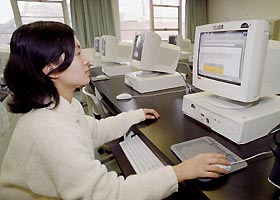|
This is an archived article.
For the latest news, go to the
Advance Homepage For more archives, go to the Advance Archive/Search Page. 
| ||
|
Students in Oskar Harmon's Economics 111 class at the Stamford campus crunch numbers in Storrs by clicking on the "send" button. The grading in Harmon's Principles of Macroeconomics class is done by Jingqiu Zhu, a first-year graduate student at the main campus. Harmon has met Zhu, who comes from China, only via Picture-Tel on the computer.
Students in the freshman class send their Excel spreadsheets to the teaching assistant by e-mail, and she returns them the same way. She hasn't met the students - or visited the Stamford campus. The arrangement resulted from Harmon's request to the chair of his department for a graduate student to grade his students' homework. "In the past, TAs have not been assigned for homework grading at the Stamford Campus because the old technology of hard copy could not overcome the hurdle created by the three- to four-hour round-trip drive from Storrs to Stamford," Harmon says. For Zhu, who also is a teaching assistant for a class in Storrs, distance is not a problem. "E-mail makes it easy to 'talk' with students in the Stamford class," she says. "I can know everything going on in Professor Harmon's class, when the midterm exam is, what questions the students have on their homework assignment. We get rid of the space barrier somewhat." The arrangement seems to be working well all round. Assignments are posted via a listserv on Monday evenings and are due on Friday before class begins. "Students read the assignment at their convenience from the e-mail account, and there is no problem of lost copies because it sits on the hotmail.com server," Harmon says. Hotmail is a free Internet-based e-mail program. The time to collect and return assignments is reduced to the click of a mouse, thus saving several minutes of valuable class time. "It's like pouring the sand out of your shoes. Many of the frictions with in-person collection and distribution of homework assignments in hard copy format are eliminated," he says. He says the students like the system for its convenience and easy record keeping. "They like being able to submit assignments any time up to the due date, and they like having an e-mail 'paper trail' to keep track of their assignments. They also like the neatness that comes with electronic copy as opposed to handwritten copy." Zhu agrees that the arrangement is going well. For one thing, she says, "I don't need to distinguish the handwriting of students, which makes the grading easier and enjoyable." Most important, the students seem to be learning. "The students have made great improvements in their homework," she says. One drawback, however, is that if students need help with their homework, e-mail is cumbersome. "For fine points," says Harmon, "it takes longer to explain oneself through electronic means than in person." To Harmon's surprise, at the start of class, only about half the students in his class were familiar with e-mail. But with the help of the graphic interfaces and help documentation of the free commercial e-mail, he says, within two weeks they were all proficient at sending and receiving e-mail and attachments. Harmon says he would like to see the program expanded. Teaching assistants are an additional teaching resource that otherwise would not be available to students in Stamford. And having a TA frees the professor's time to develop other ways to improve teaching and learning. Ken Ross |

